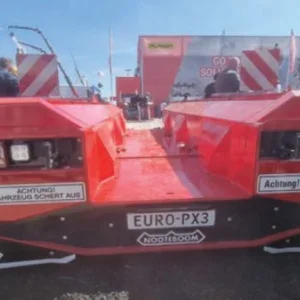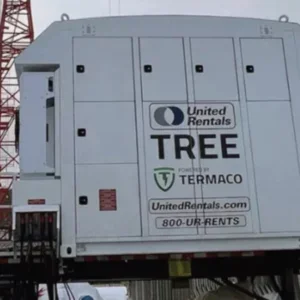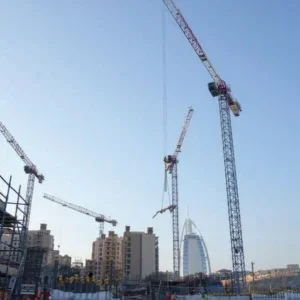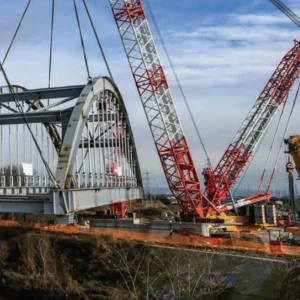
The Bauma tradeshow provides a fantastic launchpad for manufacturers looking to showcase new metal to a global audience and this April’s edition looks set to deliver with new developments from key manufacturers.
US manufacturer Manitowoc, for example, is using Bauma as the launchpad for its first ever plug-in hybrid technology Grove all terrain cranes: the GMK5150L-1e and the GMK5150XLe.
Both 150 tonne capacity cranes incorporate much of the technology that was shown in concept form at Bauma 2022 in the GMK4100L-2 hybrid.
The new cranes sport a new, fully electrified superstructure which, says Manitowoc, results in more efficient, quieter, and environmentally-friendly lifting.
BATTERY POWER
At the heart of Manitowoc’s new cranes is a battery pack that provides around 180 kWh of energy enabling them to provide a solid day’s work as a taxi crane.
The battery can be charged either from the grid (by AC or DC power supplies) or via a 170 kW generator integrated into the carrier.
This, it says, allows charging while driving, reducing owner concerns about the availability of charging infrastructure.
The cranes can even be operated while charging (providing there is infrastructure for this).
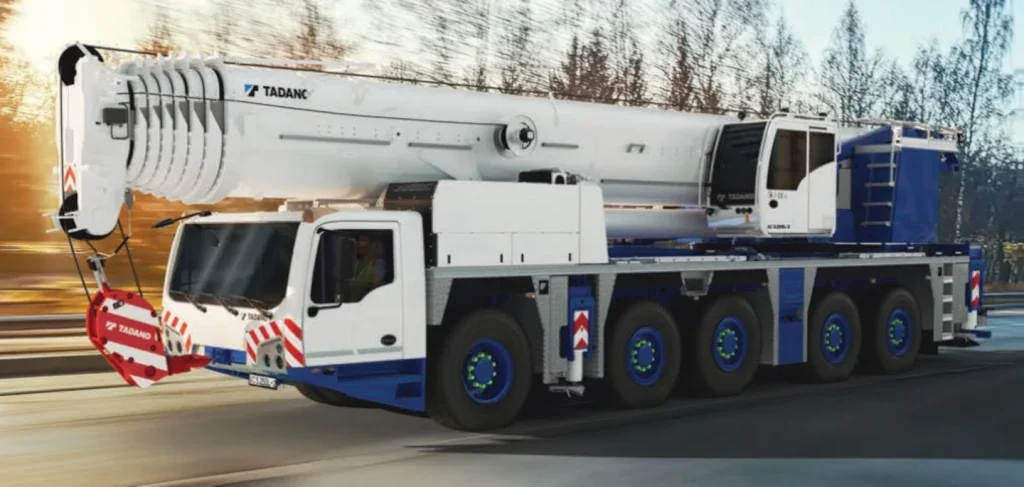
The battery pack enables approximately five hours of emissions-free lifting, says Manitowoc. When the crane is connected to the grid, crane operation can be extended to approximately 20 hours, without compromising speed or capacity.
This, it says, is more than enough functionality for a 150 tonne taxi crane and, when the day’s work is complete, the batteries are recharged while the crane is driven back to base, ready for the next working day.
ECO CRED
“These new plug-in hybrid cranes deliver more sustainable lifting and boost owners’ environmental credentials,” said Florian Peters, senior product manager for all terrain cranes at Manitowoc.
“They can drive to the job site using HVO fuel to power the efficient Mercedes-Benz engine and reduce car-bon emissions by up to 90% while simultaneously charging the batteries. Then, they can set up and use clean electricity to handle the lifting tasks. There’s also a massive reduction in noise pollution – a great advantage when operating in a city centre.”
STRONG AND RELIABLE
Adopting this more sustainable power source has no negative impact on lifting performance.
Structurally, the 60 metre main boom on the Grove GMK5150L-1e and 68.7 metre main boom on the GMK5150XLe are identical to the diesel models, as are the load charts.
The cranes also retain Grove’s Megatrak independent suspension system and disc brakes, with just minor tweaks to the driveline.
The control system is Manitowoc’s Crane Control System (CCS) with boom configurator mode and the MAXbase outrigger positioning system.
“Many cities and industrial sites are placing increasingly strict environmental requirements on machinery, so there is a need to provide customers with options to help them achieve their commercial and environmental goals,” added Peters.
“We expect a lot of interest in these hybrid cranes and are excited to unveil the GMK5150XLe at Bauma 2025.”
For more from Peters on these cranes see our exclusive interview starting on page 40.
LONG BOOM
Tadano has launched an upgraded ‘long boom’ version of its fiveaxle AC 5.250-2 all terrain: the AC 5.250L-2, which will also be showcased at Bauma.
The AC 5.250L-2 has a 79-metre-long main boom, a maximum main boom extension of 30 metres, and a load moment of up to 736 tonne metres. This high load moment is achieved with a working radius of seven metres, a 13.5-metre-long main boom and a load weight of 105.2 tonnes.
In addition, Tadano offers an optional heavy-lift attachment for even heavier loads up to 138.7 tonnes on the short boom with additional sheaves.
TAXI WORK
The crane is well suited for use as a taxi crane, says Tadano. For example, in 10 x 6 drive format, it can travel between jobsites on 16-inch steel wheels whilst carrying a large amount of kit whilst still complying with 12-tonne axle load limits.
This includes carrying items such as a 32-tonne Vario hook block and outriggers (with a total weight of less than 60 tonnes), transport brackets for extensions, and up to 250kg of equipment in the rear box.
Alternatively, in 10 x 8 drive format and with 16-inch steel wheels, the crane, with a total weight of 82.5 tonnes, complies with 16.5-tonne axle load limits whilst carrying a 32-tonne hook block, outriggers, a 12-metre extension (including transport brackets), 20 tonnes of counterweight, and up to 500kg of equipment in the rear box.
The AC 5.250L-2 can pick up its maximum counterweight of 80 tonnes in three lifts: 49.6 tonnes with a radius of up to 6.8 metres (at a full radius of 360 degrees) and two 15.2 tonnes with a radius of up to 13 metres (divided into 10 and 5.2 tonnes for hanging on the right and left of the basic package). If required, the counterweight can also be divided into smaller pieces.
For example, the 5.5-tonne base plate can be picked up from a distance of up to 23 metres in a full radius.
“Thanks to the standard IC-1 Plus crane control system, the possible radius can be increased considerably in certain areas of the slewing angle,” says Peter Kleinhans, project manager for the new AT.
For maximum transport flexibility Tadano has designed the counterweight system so that, when split up, no single element weighs more than ten tonnes. This, Tadano says, means that smaller trucks can be used for transportation at sites with restricted space.
The AC 5.250L-2 is equipped with the IC-1 Plus crane control system as standard.
A Surround View camera system can be specified. It uses six cameras to display the maximum possible extension widths of the outriggers at the crane’s current position in a computer-aided display.
“With Tadano Surround View, the crane operator can see on a display in the cab exactly how he needs to position the crane on the construction site in order to extend all outriggers sufficiently and ensure the required slewing radius,” says Kleinhans. “This eliminates the need for tedious and time-consuming measuring and trial-and-error when searching for a location, so that the crane is ready for use more quickly.”
The system also helps to better recognise pedestrians and cyclists on the way to the construction site when turning.
Tadano says the crane has been designed to make life as comfortable for the operator as possible. For example, all noiseemitting hydraulic components are positioned away from the upper cabin for noise reduction.
Both cabs are spacious, says Tadano, and safety is ensured by well-placed access steps, attachment points for the driver’s personal safety equipment, and a step that can be extended from the undercarriage for safe and convenient access to the upper cab.
A pendant light and a load view camera can be specified as optional extras. These can be mounted either on the boom head or the extensions.
The AC 5.250L-2 has the same 530 hp Mercedes engine as found on the AC 5.250-2. It provides a maximum torque of 2,600Nm. The HVO-compliant diesel engine meets EU Stage V requirements.
When in Eco Mode the crane’s engine delivers only as much power as the crane needs. These calculations are made via the IC-1 crane control system, which also includes a fuel-saving start/ stop function. This switches off the crane engine at the touch of a button without deactivating the control software. Hill start assist is fitted as standard.
Tadano believes the combination of the new model’s taxi crane capabilities and ability to lift heavy loads to great heights mean it will appeal to a wide range of customers.
SECRET REVEAL
At Bauma 2025 Liebherr is expected to launch its first ever five-axle all terrain with an electric drive and battery. Details of the crane, however, are being kept under wraps until the show – so we will bring you details on this machine as soon as we know more.
What we can tell you, however, is that, at Bauma 2025 Liebherr will also debut its latest 120-tonne LTM crane with LICCON3 control system: the LTM 1120-4.2.
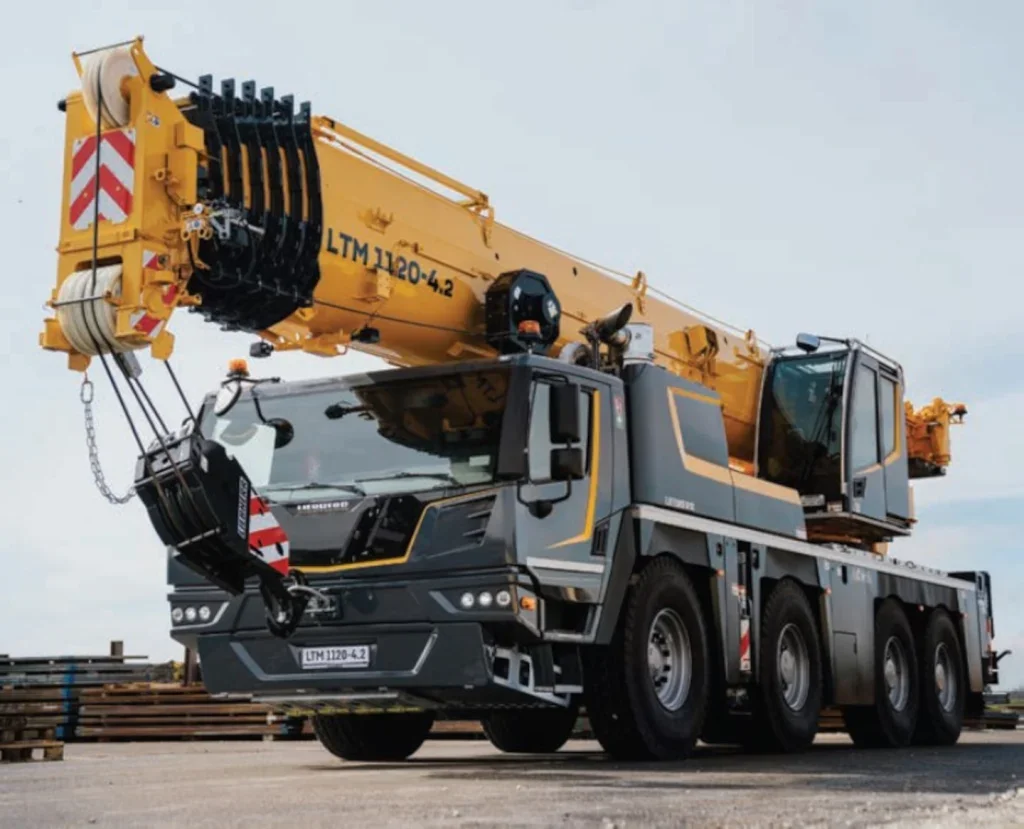
The LTM 1120-4.2 is an update of its popular 120-tonne LTM 1120-4.1 – with the new nomenclature reflecting the addition of the new LICCON3 control system.
NAME CHANGER
All new Liebherr cranes come with this latest new control system, while the company is also converting its existing crane types to LICCON3 versions.
To signify the changes, the last digit of the type designation is increasing by one (hence the LTM 1120-4.1 is now the LTM 1120- 4.2). The cranes’ performance parameters and lifting capacities remain unchanged.
This means the four-axle LTM 1120-4.2 keeps the same 66 metre, seven-section boom as seen on the LTM 1120-4.1 (the longest available on a four-axle mobile crane), along with its 10.8 to 19 metres of bi-fold swingaway extension, VarioBase outrigger set up and VarioBallast adjustable counterweight.
At full extension it can lift nine tonnes; this, says Liebherr, makes it suitable for erecting tower cranes and radio masts. Lattice extensions enable the 120-tonne crane to achieve hook heights of up to 91 m and radii of up to 64 m.
NEW GENERATION CONTROL
The LICCON3 is the third generation of the control system. Liebherr says it offers new software and programming language, faster data bus, more memory, and higher computing power.
The system still incorporates exiting hardware components such as the BTT handheld remote control console (which enables the crane operator to carry out operations such as extending the crane’s outriggers and attaching the hook block to the bumper).
In the superstructure cab the touchscreen display is bigger than before with the aim of making it easier and more comfortable to use. The way in which information is shown has also been revised and simplified. In addition, LICCON3 cranes are prepared for telemetry and fleet management as standard. This means that crane contractors will be able to view and evaluate all relevant data using the MyLiebherr customer portal.
Despite the new layout and technology the switch to using the system is simple, Liebherr adds.
CABIN COMFORTS
To complement the new control system the LTM 1120-4.2 also has a new driver’s cab. Liebherr says the cab’s modern design is made from premium materials an delivers a number of improvements for the crane driver.
These include the new multifunction steering wheel, side roller blind on the driver’s door, improved instruments and modules, plus new displays.
Optional extras such as a central locking system with remote key and a ‘coming and leaving home’ function can be specified.
In the cab there’s a new automatic heating and airconditioning system (in both the driver’s cab and the crane operator’s cab) for enhanced comfort. A sun sensor detects strong sunshine and automatically adjusts the heating settings.
The lighting packages for the crane cab, the superstructure, the rear of the vehicle, the front headlights and the telescopic boom as well as the lattice fly jib have been optimised and can be operated with LEDs. The benefits of LED technology, says Liebherr include a longer service life and superior lighting performance.
Other new elements include a DynamicPerform clutch module which Liebherr says provides al-most wear-free starting and manoeuvring for the modular ZF TraXon gearbox without overheating. It achieves this because it transmits the engine output via an oil-cooled multi-disc package.
There are also new assistance systems, such as Blind Spot Information and Moving Off Information, designed to increase driving safety in road traffic.
The LTM 1120-4.2 comes with RemoteDrive as standard. This allows the mobile crane to be driven from the outside with wireless remote control. Liebherr believes this will be a benefit on cramped construction sites.
Other new options for the LTM 1120-4.2, which Liebherr has included due to their popularity on some of its other crane types, include a central lubrication system for the chassis and a digital tyre inflation pressure display.
These latest advancements from all terrain manufacturers illustrate the rapid progress in crane technology in the AT sector, focussing on higher performance, increased efficiency, and environmental sustainability.
Bauma will provide a great opportunity to see many of these models in one place and, no doubt, competition amongst the manufacturers to attract customers will be fierce. There’s also the promise of a further model to be revealed at the show and we can’t wait to see what’s in store. We’ll bring you the details soon.
INDUSTRY FEEDBACK SEES SANY UPDATE SAC600E ALL TERRAIN FOR EUROPEAN MARKET
Since launching the Sany SAC600E all terrain crane in the UK in October 2023 Sany has made a number of design tweaks to the crane to further the crane’s appeal to the European market.
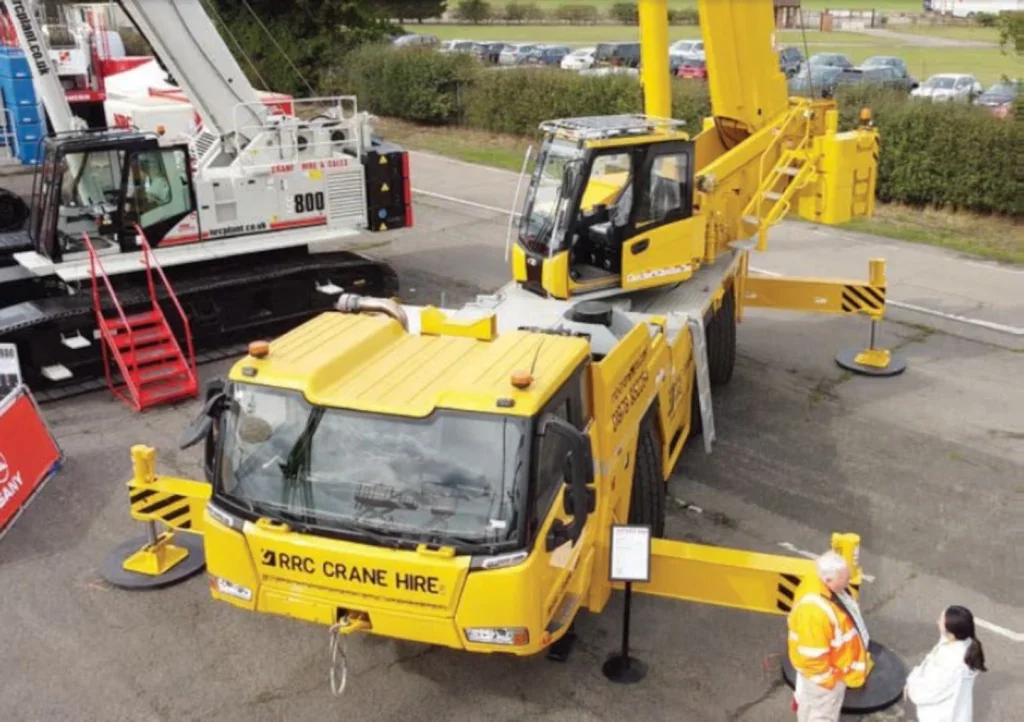
The changes came off the back of customer feedback following the availability of a demo model, plus a roadshow around the UK showcasing the crane.
“We’ve now implemented a variable outrigger system,” says Andrew Snow, country manager UK and Republic of Ireland. “This means we can now have the outriggers setup in different positions. We also have a predetermined load chart. There will be more updates on this so, in time, it will become a more variable system.”
Sany has also made minor changes to the crane’s telescopic boom, as well as altering the superstructure cab and seat so that they have more European-friendly dimensions. “Although it looks the same, the cab is slightly bigger and it’s got a different layout,” says Snow. “The electronic platform has changed, too, to enable the changes to the outrigging system.
“We have also carried out a whole host of smaller changes that you wouldn’t really notice if you didn’t know they were there. For example, we’ve made improvements to the steps, some bracketry, and lots of other things that make life easier for users, such as moving pipework and other bits to enable better access or better protection.”
Sany says these changes make the crane more robust, as well as making service and maintenance easier. “The initial product from the factory was really, really good,” concludes Snow. “We’ve just made a few tweaks to further its appeal to the European market.”
XCMG LAUNCHES FOUR AXLE ALL TERRAIN FOR EUROPE
At Bauma China, held in November 2024, Chinese manufacturer XCMG launched the four-axle XCA80G7-1E which, according to Rafael Romao, sales director at XCMG Europe, has been designed for the Euroepan market.
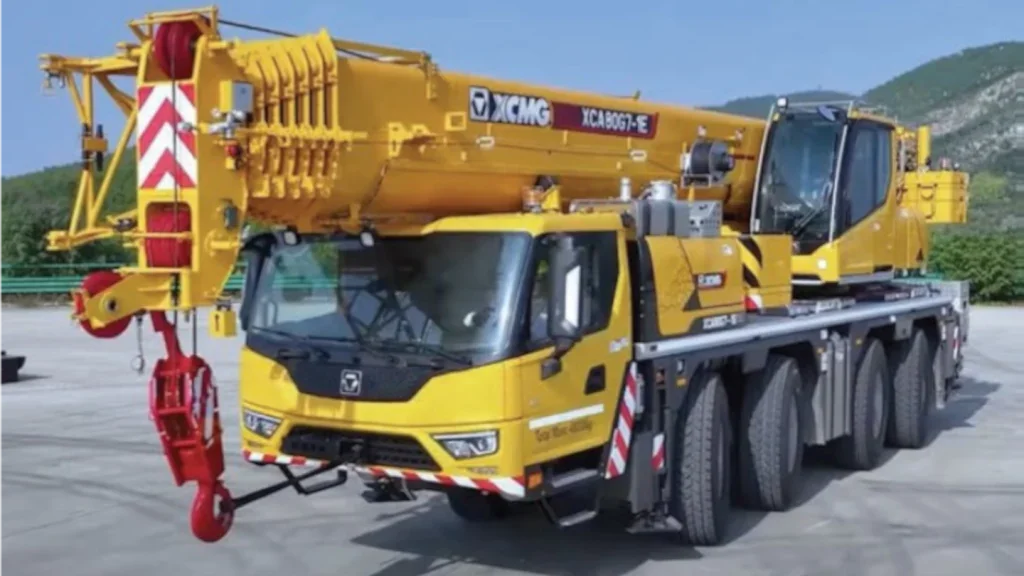
The crane has a maximum lifting capacity of 80 tonnes and a seven-section 60-metre main boom. The crane can travel on the road with up to nine tonnes of counterweight – although it is capable of carrying all 20 tonnes of counterweight for heavy-load transfer across jobsites.
There’s a single control for counterweight assembly and the crane can also extend the boom whilst carrying a load.
The XCA80G7-1E comes with a suite of 12 operator assistance functions, including one-button counterweight attachment, 360°panoramic view via cameras around the crane, and wireless remote control. XCMG says these attributes make it a great choice for complex urban projects. A YouTube video of the crane can be seen here: www.youtube.com/watch?v=lFkoqY9aY7M


